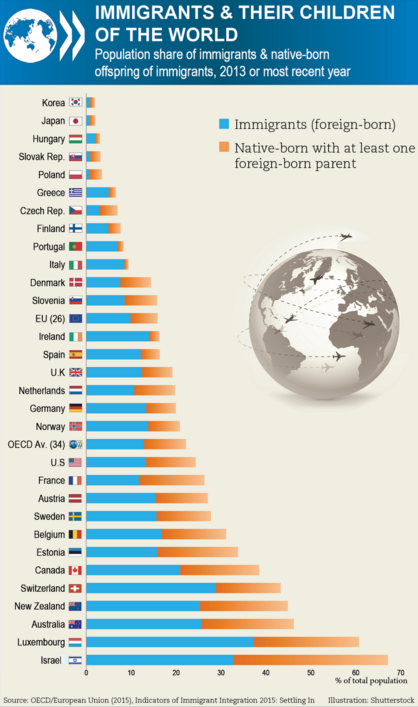Which countries have the largest immigrant populations?


Get involved with our crowdsourced digital platform to deliver impact at scale
Stay up to date:
Youth Perspectives
Luxembourg has the highest immigrant population of OECD countries, according to data compiled by the organisation.
The OECD gathered the data as part of its Indicators of Immigrant Integration 2015 report. For the purposes of the report, immigrants were defined as anyone not born in the country. This allows for cross-country comparisons, since many nations differ in their own internal definitions.
Luxembourg’s immigrant population stands at 37.3%, but if you include residents who are either foreign-born or who have at least one parent born abroad, the small European nation comes second to Israel.
In Israel, 32.7% of the 2013 population were born outside the country, while a further 34.4% of the population have at least one foreign-born parent. The top three is completed by Australia, where 25.7% of the population were born abroad.
Source: OECD
The chart highlights some interesting results, with certain nations reporting a high proportion of immigrants (as compared to residents with at least one foreign-born parent) – Portugal, Italy and Ireland, for example. In contrast, other nations report a much lower proportion of immigrants, notably in the east of Europe: the Czech Republic, Poland and the Slovak Republic.
The report also highlights major global differences in immigrant populations, with Japan and South Korea both reporting very low numbers compared with much of Europe.
The report emphasizes the challenges faced by immigrants in countries around the world, as they attempt to adapt to a new culture. Hurdles they may face include being schooled in a different education system and potentially learning a foreign language.
Have you read?
Which countries view immigration most favourably?
Why we shouldn’t confuse refugees with terrorists
Europe’s refugee crisis explained
To keep up with the Agenda subscribe to our weekly newsletter.
Author: Joe Myers is a Digital Content Producer at Formative Content.
Image: Pedestrians walk inside a train station REUTERS/Yuriko Nakao
Don't miss any update on this topic
Create a free account and access your personalized content collection with our latest publications and analyses.
License and Republishing
World Economic Forum articles may be republished in accordance with the Creative Commons Attribution-NonCommercial-NoDerivatives 4.0 International Public License, and in accordance with our Terms of Use.
The views expressed in this article are those of the author alone and not the World Economic Forum.
The Agenda Weekly
A weekly update of the most important issues driving the global agenda
You can unsubscribe at any time using the link in our emails. For more details, review our privacy policy.
More on Youth PerspectivesSee all
Andrew Moose and Ruma Bhargava
April 5, 2024
Tomoko Fukuda and Andreas Daugaard Jørgensen
March 4, 2024
Simon Torkington
January 31, 2024
Catherine Russell
January 17, 2024







